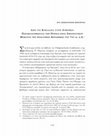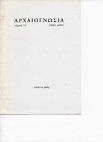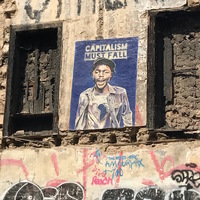Papers by Εvangelia Simantoni-Bournia
Hesperia, 1990
Archaic Chian relief ware has survived in very poor condition and has, therefore, little to contr... more Archaic Chian relief ware has survived in very poor condition and has, therefore, little to contribute to this discussion. Nevertheless, Chian relief pottery permits another kind of comparison with terracotta revetments: its decorative patterns especially, but often its fig-urative subjects, ...

The sanctuary of Hyria on Naxos, excavated between the years 1986–1998, has long attracted academ... more The sanctuary of Hyria on Naxos, excavated between the years 1986–1998, has long attracted academic attention,mainly because of its importance for the history and evolution of ancient Greek temple-architecture. Apart from thearchitectural interest, however, the study of the archaeological material brought to light enlightens us about the connectivity of the sanctuary with areas of the Aegean and the Near East over the centuries and increases our knowledge on aspects of Naxian society, especially during the early phases of historical times. Extensive research on Panhellenic sanctuaries confirmed that written testimonies, literary and epigraphic, combinedwith impressive and costly dedications, are fundamental sources of information about the origin of the donors and the network of interactions. Unfortunately, both the above are completely missing from Hyria, as well as from most of the sanctuaries of the Cyclades. We are, therefore, obliged to settle for the imported pottery and the m...

AURA 4, 2021
The sanctuary of Hyria on Naxos, excavated between the years 1986-1998, has long attracted academ... more The sanctuary of Hyria on Naxos, excavated between the years 1986-1998, has long attracted academic attention, mainly because of its importance for the history and evolution of ancient Greek temple-architecture. Apart from the architectural interest, however, the study of the archaeological material brought to light enlightens us about the connectivity of the sanctuary with areas of the Aegean and the Near East over the centuries and increases our knowledge on aspects of Naxian society, especially during the early phases of historical times. Extensive research on Panhellenic sanctuaries confirmed that written testimonies, literary and epigraphic, combined with impressive and costly dedications, are fundamental sources of information about the origin of the donors and the network of interactions. Unfortunately, both the above are completely missing from Hyria, as well as from most of the sanctuaries of the Cyclades. We are, therefore, obliged to settle for the imported pottery and the minor objects/ offerings found in these sites. There is no doubt that the sanctuary of Hyria takes precedence over the other sanctuaries of Naxos in terms of the quantity of small dedications, be they local imitations or imported, in clay or in more valuable materials. This paper attempts to identify cultural and commercial relations of the islanders with the wider Aegean and the Eastern Mediterranean areas, as documented by the analysis of pottery and of the minor objects found in the sanctuary and to show to what extent the emerging image complements our knowledge from previous relevant studies.

Αρχαιογνωσία 15, 2007
FROM THE CYCLADES TO THE EUBOEAN GULF:
TRACKING A 7th C. BC ICONOGRAPHIC THEME
Birds of prey lac... more FROM THE CYCLADES TO THE EUBOEAN GULF:
TRACKING A 7th C. BC ICONOGRAPHIC THEME
Birds of prey lacerating fallen human figures, probably fallen warriors, is a rare
iconographic theme which makes its first appearance in Greek iconography
in the last decade of the 8th c. BC on a relief sherd from Tenos. The subject is
repeated on the last zone of a fragmentary relief amphora from Eretria of the first
quarter of 7th c. BC and on a relief amphora sherd from Xombourgo, Tenos, of
c. 660 BC. Two more possible instances of the subject are known, on a bronze
shield band from the Akropolis of Athens and on a steatite gem from Melos (?),
both of the 6th c. BC.
The present article deals with the ancestry of this iconographic theme and seeks
the causes for its disappearance from Greek art of the classical and later periods.
The iconographic ancestors of the "birds of prey devouring corpses" are to be
found in the Near East as early as the 3rd millennium BC and its immediate relatives
on a stone relief commemorating a victory of Sennacherib in Nineveh, of the
late 8th/early 7th c. BC. It is suggested that the iconographic subject decorating a
small hydria of LH IIIA2 date could be considered as a Mycenaean parallel for the
subject, which illustrates in the most eloquent way the first verses of the Iliad.
The reason for the disappearance of the “birds of prey devouring corpses” from
later art is sought in the prevalence of a more humanitarian and idealistic spirit in
the Classical and Hellenistic periods. The distribution of this iconographic theme
in the Cyclades, Attica and Euboea, is a possible indication of the route followed
by Cycladic itinerant artists of the early 7th c. BC bringing along and disseminating
new and sometimes peculiar iconographic subjects.
AURA, 2019
Βιβλιοκρισία Σκιλάρντι, Δ. 2016. Κουκουναριές Πάρου. Οι ανασκαφές και η ιστορία της πανάρχαιης ακ... more Βιβλιοκρισία Σκιλάρντι, Δ. 2016. Κουκουναριές Πάρου. Οι ανασκαφές και η ιστορία της πανάρχαιης ακρόπολης του Αιγαίου. Αθήνα: Ανασκαφές Πάρου, Κέντρο Ιστορικών και Αρχαιολογικών Σπουδών. ISBN 978-960-91596-1-6. Σελ.96, έγχρωμες φωτογραφίες, χαρτόδετο. Αγγλική έκδοση: Schilardi, D.-U. 2016. Koukounaries Paros. The excavations and history of a most ancient Aegean acropolis. Athens: Paros excavations-Center of Historical and Archaeological Studies. ISBN 978-960-91596-1-6. Σελ. 95, έγχρωμες φωτογραφίες, χαρτόδετο. Ιταλική έκδοση: Schilardi, D.-U. 2016. Koukounaries di Paros. Gli scavi e la storia di una antichissima acropoli dell'Egeo. Atene: Scavi di Paros. Centro di studi storici e archeologici di Paros. ISBN 978-960-91596-1-6. Σελ. 95, έγχρωμες φωτογραφίες, χαρτόδετο. Α U R A 2 ( 2 0 1 9 ) : 3 0 7 -1 1
Mitteilungen des DAI, Athenische Abteilung, Bd 113, 1998

The quantity of jewellery excavated in the Sanctuary of Hyria, Naxos, is considerable compared to... more The quantity of jewellery excavated in the Sanctuary of Hyria, Naxos, is considerable compared to what was found in other Naxian Sanctuaries. Among the best preserved pieces are two bronze and one ivory figure of eight fibulae of the late 8th/early 7th c. BC and two arched bronze fibulae of the island type, of about the same period. A silver earring and a bronze finger ring are dated by context to the late 7th c. BC. A second bronze finger ring dates, on stylistic grounds, to the 4th c. BC. On the floor of the Early Archaic Estiatorion an excellently preserved bracelet made of bronze beads stuck together, was discovered. It dates to the late 7th/early 6th c. BC. Two pendants, a small bronze bird and a chiseled cowry shell are dated by context between 700 and the first quarter of the 7th c. BC. The trade routes by which the models of the above jewellery have reached the island are briefly examined.
During the 1989 excavation at Hyria on Naxos a clay double stamp was found in a non stratified de... more During the 1989 excavation at Hyria on Naxos a clay double stamp was found in a non stratified deposit, containing pottery which ranged from LG to the Early Hellenistic period. Its shape is unique among the clay stamps and seals known so far: the main part of it can be compared to the marble rectangular LG seals, but its upper, smaller side is elongated to form a stem perforated horizontally in mid height, so as to hang from a string. The larger stamping surface bears the representation of a lion walking to the right, the smaller surface a winged horse. Both are in concave relief. The clay stamp dates from the early second quarter of the 7th c. BC.
A lekythos in human form, dated on stylistic and contextual grounds within the first decade of he... more A lekythos in human form, dated on stylistic and contextual grounds within the first decade of he 7th c. BC, was uncovered in the Sanctuary of Hyria on Naxos. The find bears striking resemblance to female clay figurines fabricated on the potter’s wheel and to vases shaped in human form, which were offered in Cypriot, Cretan, Rhodian and Samian sanctuaries from the Late Bronze-age until the well advanced historic era. The paper deals with the prehistoric origins of the shape of the Naxian Lekythos, and assesses the connotations of such a find in the sanctuary of Hyria, where cult activity is testified from LH III B onwards.
ΧΑιρεΤιΣΜΟι 9 Μ. Κόμβου, Έργα πολιτισμού στο Αιγαίο και συγχρηματοδοτούμενα προγράμματα 17 ΒΟρειΟ... more ΧΑιρεΤιΣΜΟι 9 Μ. Κόμβου, Έργα πολιτισμού στο Αιγαίο και συγχρηματοδοτούμενα προγράμματα 17 ΒΟρειΟ ΑιΓΑιΟ Χ. ρωμάνου, Στ. Μπονάτσος, εργασίες προστασίας, συντήρησης και ανάδειξης του οχυρωμένου προϊστορικού οικισμού στο παλαμάρι της ςκύρου στο πλαίσιο των κοινωνικών ςυγχρηματοδοτούμενων προγραμμάτων (Γ΄ κπς και εςπΑ) 21 Π. Βαλάκου, το κάστρο της Χίου. Δεκαπέντε χρόνια επεμβάσεων αποκατάστασης και ανάδειξης 33 Α. Καββαδία, νέα μουσεία σε Χίο και ςάμο του Γ΄ κοινοτικού πλαισίου ςτήριξης 45 ευ. Μαυρίκου, ο πύργος του Λυκούργου Λογοθέτη στο πυθαγόρειο της ςάμου 61 -ΝΟΤιΟ ΑιΓΑιΟ -ΚΥΚΛΑΔεΣ
The paper, based on the pottery uncovered during the excavation of the Hyria sanctuary on Naxos, ... more The paper, based on the pottery uncovered during the excavation of the Hyria sanctuary on Naxos, attempts to investigate the existence or absence of affinities detectable in the ceramic production of Naxos and Paros, the two most important Cycladic islands in the 8th and 7th centuries BC. These two city-states of the central Aegean were renowned for the enmity separating them in the early historical period, a conflict referred to by many ancient literary sources. The approach is primarily stylistic; we are, nevertheless, interested also in actual imports, trying to understand how the political clash affected the economic practices and the everyday life of the islanders.

The neck panel of a relief amphora from Boeotia in the National Archaeological Museum and a fragm... more The neck panel of a relief amphora from Boeotia in the National Archaeological Museum and a fragment from
Xobourgo in the Museum of Tenos are decorated with an impressive frontal figure with upraised arms escorted by two small attendants pressed closely against her. Two lions in profile rear on either side of this central group. In this chapter, the different approaches to the iconographic subject are considered and a new reading of the image proposed, interpreting it as an optical
transcript of Iliad 21.479-84 according to which Artemis could behave as a lion towards women and was, by Zeus’ permission, free to kill whomever she wished. It is suggested that the frontal figures on the neck panels represent Artemis as Potnia, while the small female worshippers attempt to placate the all-powerful deity, asking her to avert the danger embodied in the lions,
and to protect them in marriage, pregnancy and labour. The paper locates other iconographic subjects of the same period and on the same pottery type that apparently represent visual translations of Homeric verses.
The first part of the paper deals with the trip of the members of the Expedition Archeologique de... more The first part of the paper deals with the trip of the members of the Expedition Archeologique de Moree to Sounion and Aegina.
The second part relates their trip to Athens.
A brief overview of the mythological background of Naxos island in ancient times
The study of the Hellenistic pottery from the sanctuary of Hyria corroborates the opinion that al... more The study of the Hellenistic pottery from the sanctuary of Hyria corroborates the opinion that although Naxos followed closely the fate of other Aegean islands in the Hellenistic period, no serious economic decline can be ascertained for the island, at least not until the Mithridatic wars. The difficulty in discerning between imported and locally produced ware, a serious handicap for the study of Naxian ceramics already in the archaic period, becomes more evident in the Hellenistic era. There is nothing unique or peculiar about Naxian Hellenistic vessels; they follow largely the standard types already known from other parts of the Greek world and are mostly drinking and eating ware. Their main finding spots prove that since the 4th c. BC onwards, ritual banquets that were at the core of the Hyria celebrations were performed solely in the hestiatorion area.











Uploads
Papers by Εvangelia Simantoni-Bournia
TRACKING A 7th C. BC ICONOGRAPHIC THEME
Birds of prey lacerating fallen human figures, probably fallen warriors, is a rare
iconographic theme which makes its first appearance in Greek iconography
in the last decade of the 8th c. BC on a relief sherd from Tenos. The subject is
repeated on the last zone of a fragmentary relief amphora from Eretria of the first
quarter of 7th c. BC and on a relief amphora sherd from Xombourgo, Tenos, of
c. 660 BC. Two more possible instances of the subject are known, on a bronze
shield band from the Akropolis of Athens and on a steatite gem from Melos (?),
both of the 6th c. BC.
The present article deals with the ancestry of this iconographic theme and seeks
the causes for its disappearance from Greek art of the classical and later periods.
The iconographic ancestors of the "birds of prey devouring corpses" are to be
found in the Near East as early as the 3rd millennium BC and its immediate relatives
on a stone relief commemorating a victory of Sennacherib in Nineveh, of the
late 8th/early 7th c. BC. It is suggested that the iconographic subject decorating a
small hydria of LH IIIA2 date could be considered as a Mycenaean parallel for the
subject, which illustrates in the most eloquent way the first verses of the Iliad.
The reason for the disappearance of the “birds of prey devouring corpses” from
later art is sought in the prevalence of a more humanitarian and idealistic spirit in
the Classical and Hellenistic periods. The distribution of this iconographic theme
in the Cyclades, Attica and Euboea, is a possible indication of the route followed
by Cycladic itinerant artists of the early 7th c. BC bringing along and disseminating
new and sometimes peculiar iconographic subjects.
Xobourgo in the Museum of Tenos are decorated with an impressive frontal figure with upraised arms escorted by two small attendants pressed closely against her. Two lions in profile rear on either side of this central group. In this chapter, the different approaches to the iconographic subject are considered and a new reading of the image proposed, interpreting it as an optical
transcript of Iliad 21.479-84 according to which Artemis could behave as a lion towards women and was, by Zeus’ permission, free to kill whomever she wished. It is suggested that the frontal figures on the neck panels represent Artemis as Potnia, while the small female worshippers attempt to placate the all-powerful deity, asking her to avert the danger embodied in the lions,
and to protect them in marriage, pregnancy and labour. The paper locates other iconographic subjects of the same period and on the same pottery type that apparently represent visual translations of Homeric verses.
The second part relates their trip to Athens.
TRACKING A 7th C. BC ICONOGRAPHIC THEME
Birds of prey lacerating fallen human figures, probably fallen warriors, is a rare
iconographic theme which makes its first appearance in Greek iconography
in the last decade of the 8th c. BC on a relief sherd from Tenos. The subject is
repeated on the last zone of a fragmentary relief amphora from Eretria of the first
quarter of 7th c. BC and on a relief amphora sherd from Xombourgo, Tenos, of
c. 660 BC. Two more possible instances of the subject are known, on a bronze
shield band from the Akropolis of Athens and on a steatite gem from Melos (?),
both of the 6th c. BC.
The present article deals with the ancestry of this iconographic theme and seeks
the causes for its disappearance from Greek art of the classical and later periods.
The iconographic ancestors of the "birds of prey devouring corpses" are to be
found in the Near East as early as the 3rd millennium BC and its immediate relatives
on a stone relief commemorating a victory of Sennacherib in Nineveh, of the
late 8th/early 7th c. BC. It is suggested that the iconographic subject decorating a
small hydria of LH IIIA2 date could be considered as a Mycenaean parallel for the
subject, which illustrates in the most eloquent way the first verses of the Iliad.
The reason for the disappearance of the “birds of prey devouring corpses” from
later art is sought in the prevalence of a more humanitarian and idealistic spirit in
the Classical and Hellenistic periods. The distribution of this iconographic theme
in the Cyclades, Attica and Euboea, is a possible indication of the route followed
by Cycladic itinerant artists of the early 7th c. BC bringing along and disseminating
new and sometimes peculiar iconographic subjects.
Xobourgo in the Museum of Tenos are decorated with an impressive frontal figure with upraised arms escorted by two small attendants pressed closely against her. Two lions in profile rear on either side of this central group. In this chapter, the different approaches to the iconographic subject are considered and a new reading of the image proposed, interpreting it as an optical
transcript of Iliad 21.479-84 according to which Artemis could behave as a lion towards women and was, by Zeus’ permission, free to kill whomever she wished. It is suggested that the frontal figures on the neck panels represent Artemis as Potnia, while the small female worshippers attempt to placate the all-powerful deity, asking her to avert the danger embodied in the lions,
and to protect them in marriage, pregnancy and labour. The paper locates other iconographic subjects of the same period and on the same pottery type that apparently represent visual translations of Homeric verses.
The second part relates their trip to Athens.